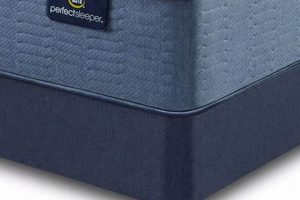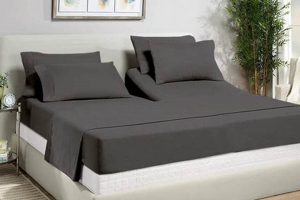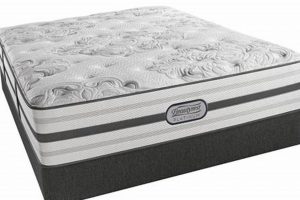The largest standard mattress size available, it caters to individuals and couples who require substantial sleeping space. This oversized bed offers considerable width and length, exceeding that of a standard king or California king. It is often chosen to accommodate multiple sleepers, children, or pets, ensuring ample personal space for everyone. For example, a family who enjoys co-sleeping might find this a more comfortable solution than a smaller option.
Its primary benefit is providing significantly more room for undisturbed rest, mitigating issues such as partner disturbance and allowing for more varied sleeping positions. Historically, such extra-large mattresses were custom-made and associated with luxury. Today, while still a premium product, they are increasingly accessible due to growing demand. The generous dimensions can improve sleep quality, which in turn positively impacts overall health and well-being.
The following sections will delve into the specific dimensions, considerations for purchasing, logistical challenges associated with its size, available bedding options, and alternatives for those seeking more space but perhaps not at such a grand scale.
Considerations for an Extra-Large Sleep Surface
The acquisition of an oversized sleep surface necessitates careful planning and assessment to ensure a suitable and beneficial experience. The following guidelines provide insights for prospective purchasers:
Tip 1: Room Dimensions Assessment: Prior to purchase, meticulously measure the intended room. An appropriately sized room is crucial to comfortably accommodate the expansive dimensions, allowing for adequate space for movement and additional bedroom furniture. A space that is too small will lead to a cramped and impractical environment.
Tip 2: Structural Reinforcement Considerations: The significant weight of the sleeping surface, particularly with multiple occupants, may necessitate reinforcing the floor structure. Consult a structural engineer to evaluate load-bearing capacity, especially in older homes or apartments. This preemptive measure helps prevent potential structural damage.
Tip 3: Specialized Bedding Procurement: Standard bedding sizes are incompatible. Source custom or specialized linens, comforters, and blankets designed specifically for the unusually large dimensions. Factor in the increased cost associated with these specialty items when budgeting for the purchase.
Tip 4: Transportation Logistics: Consider the logistical challenges of transporting the sleeping surface. Ensure that doorways, hallways, and stairwells are sufficiently wide to accommodate its passage. Professional moving services experienced with oversized items are often required to avoid damage to the mattress or property.
Tip 5: Foundation and Frame Selection: A robust and supportive foundation is essential. Standard bed frames are inadequate. Invest in a custom-built or heavy-duty frame engineered to handle the weight and prevent sagging. A stable foundation ensures even weight distribution and prolongs the mattress’s lifespan.
Tip 6: Cost Implications: Understand that the initial purchase price is just one component of the overall expense. Factor in the costs of custom bedding, specialized transportation, reinforced flooring (if needed), and potential increases in heating or cooling costs due to the increased surface area.
Tip 7: Long-Term Maintenance: Rotating and flipping, if applicable to the mattress type, can be challenging due to its size and weight. Consider professional mattress cleaning services to maintain hygiene and prolong its lifespan. Addressing wear and tear promptly helps to preserve its integrity.
These considerations are essential for those contemplating an extra-large sleep surface. Careful planning and execution ensures a positive experience and mitigates potential issues associated with the substantial size.
The subsequent sections will explore alternative oversized sleeping options and delve into the advantages and disadvantages of choosing this particular mattress size for individual sleep needs.
1. Spacious Sleeping Area
The defining characteristic of an Alaskan king mattress is its exceptionally spacious sleeping area. This feature is not merely a descriptive attribute but the core reason for its existence and primary driver of its appeal. The significantly increased surface area, compared to standard king or queen mattresses, directly translates to greater individual space for each sleeper. This alleviates common issues such as partner disturbance, edge hogging, and overall feelings of confinement during sleep. The larger area allows individuals to stretch, move, and assume diverse sleeping positions without encroaching on another person’s space. For instance, couples with different sleep schedules or restless sleepers frequently find an Alaskan king mattress essential for maintaining undisturbed rest.
The demand for this spaciousness extends beyond couples. Families who co-sleep with children or pet owners who share their bed often select an Alaskan king to provide sufficient room for everyone. The substantial increase in width and length compared to other mattress sizes makes a tangible difference in the comfort and quality of sleep experienced. This difference is not just theoretical; it is borne out in reports of reduced sleep-related arguments, increased feelings of relaxation, and improved overall sleep satisfaction. The spacious area mitigates the likelihood of physical contact leading to awakening or discomfort, enabling longer and more restful sleep cycles.
In conclusion, the connection between a spacious sleeping area and the Alaskan king mattress is one of inherent purpose. The generous dimensions are not simply an added luxury; they are the foundational element addressing the needs of individuals and families requiring significantly more sleeping space than standard mattress sizes can provide. While logistical and financial considerations exist, the benefit of enhanced sleep quality and reduced disturbance makes it a compelling option for those prioritizing undisturbed rest.
2. Oversized Bedding Needed
The unique dimensions of an Alaskan king mattress necessitate specialized bedding, a critical factor influencing the overall cost and convenience associated with ownership. Standard bedding sizes are incompatible, requiring dedicated sourcing and often custom solutions.
- Non-Standard Dimensions
The primary challenge is the sheer size. Typical king-size sheets, comforters, and blankets are substantially smaller, leaving significant portions of the mattress uncovered. This not only impacts aesthetics but also undermines the functionality of bedding in providing warmth and protection. For instance, a standard king-size flat sheet would be insufficient to tu
ck under an Alaskan king mattress. - Limited Availability
Unlike standard sizes, oversized bedding for Alaskan king mattresses is not readily available in most retail outlets. Consumers often must rely on specialty stores, online retailers, or custom-made options. This limited availability increases the time and effort required to procure suitable bedding.
- Increased Cost
The specialized nature of oversized bedding results in higher prices compared to standard sizes. The cost of materials and labor involved in producing larger sheets, comforters, and duvet covers contributes to the elevated price point. As an example, a custom-made duvet cover could cost several times more than a standard king-size option.
- Customization Challenges
Opting for custom-made bedding can present additional challenges. Ensuring accurate measurements, selecting appropriate fabrics, and coordinating with manufacturers requires careful attention to detail. Moreover, custom orders often have longer lead times and may not be returnable, adding complexity to the purchasing process.
The correlation between the Alaskan king mattress and the need for oversized bedding is undeniable and directly impacts the ownership experience. The expense and effort required to obtain appropriate linens should be a significant consideration for prospective buyers. Understanding these implications is crucial for making an informed decision.
3. Room Size Constraints
The substantial dimensions of an Alaskan king mattress directly correlate with stringent room size requirements, presenting a primary constraint for potential owners. This oversized sleeping surface demands significantly more floor space than standard mattress sizes, impacting room layout and overall functionality. The effect of neglecting room size considerations is a cramped and impractical living environment, negating the benefits of the spacious sleeping area. For instance, placing this mattress in a small bedroom leaves minimal space for essential furniture, hindering movement and creating a sense of confinement. Therefore, understanding the spatial demands becomes a crucial component in evaluating the practicality of owning this large mattress.
Adequate room dimensions not only accommodate the mattress itself but also allow for comfortable passage around the bed and the placement of ancillary bedroom furniture, such as nightstands, dressers, and seating. A room that fails to meet these requirements compromises usability and aesthetic appeal. For example, attempting to incorporate an Alaskan king mattress into a standard-sized apartment bedroom may necessitate removing other furniture pieces, leading to a diminished quality of life. Furthermore, insufficient space can impede proper ventilation and increase the risk of damage to both the mattress and surrounding furniture.
In summary, the necessity of considering room size constraints represents a significant challenge for prospective Alaskan king mattress owners. Failing to address this crucial factor can lead to a variety of practical and aesthetic problems. The understanding of these spatial demands is paramount for ensuring a comfortable and functional bedroom environment and a worthwhile investment in enhanced sleep quality.
4. Weight and Support
The inherent size of an Alaskan king mattress directly translates to a substantial increase in weight, thereby placing significant demands on the bed frame and underlying floor structure. This weight, often exceeding several hundred pounds, necessitates a robust support system capable of evenly distributing the load and preventing premature sagging or structural damage. The consequence of inadequate support is not merely discomfort but potentially costly repairs to both the mattress and the surrounding infrastructure. For instance, a standard bed frame designed for a queen-size mattress is highly unlikely to withstand the concentrated weight of an Alaskan king, leading to bending, breakage, and an uneven sleeping surface. Therefore, the relationship between weight and support is a crucial consideration in the long-term viability of owning this oversized mattress.
The selection of a suitable bed frame or foundation must account for both the static weight of the mattress and the dynamic weight of the occupants. Reinforced steel frames, custom-built wooden platforms, or adjustable bases designed for heavy loads are common solutions. Additionally, consideration should be given to the floor’s load-bearing capacity, particularly in older homes or apartment buildings. Consulting a structural engineer may be necessary to assess whether additional reinforcement is required to prevent floor sagging or potential structural failure. Real-world examples include cases where inadequate support has resulted in floors bowing or even collapsing under the combined weight of the mattress and occupants, highlighting the importance of proactive assessment and reinforcement.
In conclusion, the weight of an Alaskan king mattress represents a significant engineering challenge that must be addressed through careful selection of a robust support system and assessment of the floor’s structural integrity. Neglecting this aspect can lead to costly repairs and potential safety hazards. Understanding the interplay between weight and support is paramount to ensuring the longevity, comfort, and safety associated with owning this oversized sleeping surface.
5. Transportation Challenges
The sheer size of an Alaskan king mattress presents significant logistical hurdles during transportation, differentiating it sharply from standard-sized mattresses. Its dimensions, substantially exceeding those of a king or California king, often preclude conventional methods of delivery. This necessitates specialized handling and equipment, increasing transportation costs and potentially extending delivery timelines. For instance, standard delivery trucks may lack the space to accommodate the mattress without risking damage, requiring the use of flatbed trucks or oversized vans. Internal transport within buildings also presents obstacles, as the mattress may not fit through doorways, hallways, or stairwells, demanding careful maneuvering and, in some cases, temporary removal of architectural elements.
The challenges extend beyond mere physical size. The weight of the mattress, combined with its unwieldiness, requires a greater number of personnel for safe handling. Damage during transport is a significant concern, as the mattress’s large surface area increases its vulnerability to punctures, tears, and compression. Protective packaging and specialized moving techniques are essential to mitigate these risks. Instances of damage incurred during transportation often result in costly returns or repairs, underscoring the importance of employing experienced movers familiar with handling oversized items. Furthermore, accessibility to the delivery location plays a crucial role; homes located in remote areas or those with limited access points may incur additional charges or require alternative delivery arrangements.
In summary, the transportation of an Alaskan king mattress is a complex proce
ss demanding careful planning, specialized equipment, and experienced personnel. The size and weight of the mattress pose significant challenges, increasing transportation costs and the risk of damage. Understanding these challenges is essential for both retailers and consumers to ensure a smooth and successful delivery, avoiding potential delays and unnecessary expenses. The practical significance lies in the necessity of proactive planning and preparation to overcome these logistical hurdles inherent in handling such an oversized item.
Frequently Asked Questions
The following addresses common inquiries and concerns regarding the purchase and ownership of an Alaskan king mattress, focusing on providing clear and factual information.
Question 1: What are the exact dimensions of an Alaskan king mattress?
An Alaskan king mattress typically measures 108 inches in width and 108 inches in length (9 feet by 9 feet). These dimensions can vary slightly depending on the manufacturer, but this is the standard size.
Question 2: How does the cost of an Alaskan king mattress compare to other mattress sizes?
An Alaskan king mattress is significantly more expensive than standard sizes like queen, king, or California king. The increased material usage and specialized manufacturing processes contribute to the higher price point.
Question 3: What types of bed frames are suitable for an Alaskan king mattress?
Standard bed frames are inadequate. A custom-built or heavy-duty reinforced steel frame specifically designed to support the weight and dimensions of an Alaskan king mattress is required.
Question 4: Is special bedding required for an Alaskan king mattress?
Yes, standard bedding sizes are incompatible. Custom-made or specialized oversized sheets, comforters, and blankets must be sourced separately. This adds to the overall expense of ownership.
Question 5: How difficult is it to move an Alaskan king mattress?
Moving an Alaskan king mattress presents considerable logistical challenges due to its size and weight. Professional movers with experience handling oversized items are strongly recommended.
Question 6: Are there any health considerations associated with using an Alaskan king mattress?
There are no specific health considerations directly linked to the mattress itself. However, the increased space may improve sleep quality by reducing partner disturbance, which indirectly benefits overall health.
The information presented clarifies key aspects of Alaskan king mattress ownership, emphasizing the importance of considering size, cost, support, and logistics.
Subsequent sections will explore alternative oversized sleeping options and the long-term investment value associated with an Alaskan king mattress.
Conclusion
The preceding exploration has detailed various facets of the Alaskan king mattress, ranging from its considerable dimensions and the implications for room size to the necessity of specialized bedding and the logistical complexities of transportation. The substantial investment required, encompassing the mattress itself, the supportive foundation, and the custom-sized linens, underscores the commitment involved in acquiring such an oversized sleeping surface. Furthermore, the structural considerations for floor support highlight the need for thorough planning and assessment.
Ultimately, the decision to invest in an Alaskan king mattress should be driven by a clear understanding of its unique requirements and the potential benefits it offers. While the initial outlay may be significant, the enhanced sleeping space and potential improvement in sleep quality represent a tangible return for those who prioritize undisturbed rest. Prospective buyers are encouraged to carefully evaluate their individual needs and circumstances to determine whether the Alaskan king mattress aligns with their long-term sleep goals and lifestyle. The informed consumer is the best advocate for a restful night.



![Best California King Casper Mattress [Guide] + Deals Organic & Natural Mattress Buyer’s Guide: Non-Toxic Sleep Solutions Best California King Casper Mattress [Guide] + Deals | Organic & Natural Mattress Buyer’s Guide: Non-Toxic Sleep Solutions](https://mattressworldpa.com/wp-content/uploads/2025/07/th-8230-300x200.jpg)

![Best Adjustable King Mattress For [Benefit/User] - [Brand] Organic & Natural Mattress Buyer’s Guide: Non-Toxic Sleep Solutions Best Adjustable King Mattress For [Benefit/User] - [Brand] | Organic & Natural Mattress Buyer’s Guide: Non-Toxic Sleep Solutions](https://mattressworldpa.com/wp-content/uploads/2025/07/th-8228-300x200.jpg)

